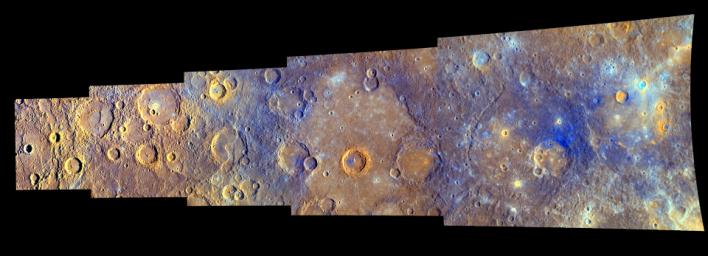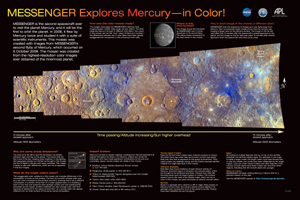
|
MESSENGER Explores Mercury - In Color
- Click the image above for a larger view
- Full-Res JPEG (4425 x 1600) (976.8 kB)
- Full-Res TIFF (4425 x 1600) (21.2 MB)
Caption:

Click on the image for larger poster version
During MESSENGER's second flyby of Mercury, MDIS acquired a strip of high-resolution images obtained with each of the WAC's 11 different color filters. The graphic shown here displays the resulting enhanced-color mosaic and gives considerable detail about the images, how the mosaic was created, and the geologic features that can be seen.
Currently, these images are the highest-resolution color images ever obtained of the Solar System's innermost planet, but not for long! On March 18, 2011, MESSENGER will enter into orbit about Mercury, and the mission's extensive, year-long science observation campaign will begin. That campaign includes capturing color images of Mercury's surface at higher resolution than ever before.
Special thanks to Kathryn Powell, a summer intern student with the MESSENGER project, for contributing to the content of this graphic. Note: since the original creation of this graphic, the crater identified in the upper right with the label "young rayed crater" has been named Dominici. See PIA12871 to learn more about this recently named crater.
Date Acquired:
October 6, 2008
Instrument:
Wide Angle Camera (WAC) of the Mercury Dual Imaging System (MDIS)
Background Info:
These images are from MESSENGER, a NASA Discovery mission to conduct the first orbital study of the innermost planet, Mercury. For information regarding the use of images, see the MESSENGER image use policy .
Cataloging Keywords:
| Name | Value | Additional Values |
|---|---|---|
| Target | Mercury | |
| System | ||
| Target Type | Planet | |
| Mission | MESSENGER | |
| Instrument Host | MESSENGER | |
| Host Type | Orbiter | |
| Instrument | Mercury Dual Imaging System (MDIS) | |
| Detector | Wide Angle Camera (WAC) | |
| Extra Keywords | Color, Crater | |
| Acquisition Date | ||
| Release Date | 2011-01-25 | |
| Date in Caption | 2008-10-06 | 2011-03-18 |
| Image Credit | NASA/Johns Hopkins University Applied Physics Laboratory/Carnegie Institution of Washington | |
| Source | photojournal.jpl.nasa.gov/catalog/PIA13823 | |
| Identifier | PIA13823 | |
